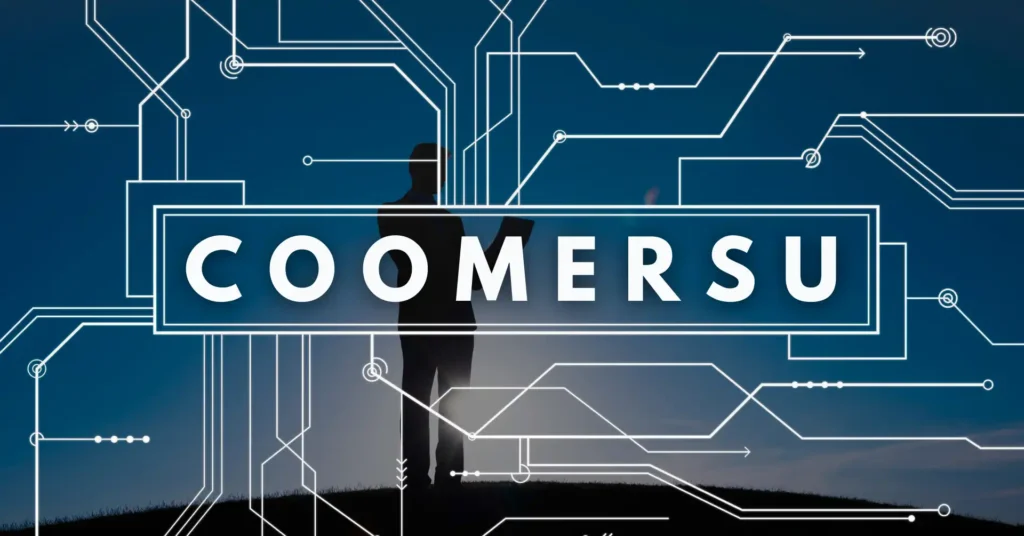Introduction to Coomersu
In today’s rapidly evolving online culture, new terms and memes emerge almost daily, reflecting deep shifts in behavior, identity, and social dynamics. One such term that has gained attention, especially in niche internet communities, is “Coomersu.” A portmanteau of “coomer” and “consumer,” Coomersu is more than just a meme—it’s a commentary on the growing phenomenon of compulsive digital consumption, especially in fandom and consumerist spaces. But what does it mean to be a Coomersu, and what does this archetype reveal about our culture?
The Birth of a Meme
The term “Coomersu” first began surfacing on internet forums like 4chan, Reddit, and Twitter (now X) in the early 2020s. It combines the idea of the “coomer”—a slang term that represents someone with an excessive addiction to pornography or instant gratification—with the hyper-consumer: someone who aggressively buys and collects merchandise, especially from pop culture franchises, often driven by emotional or psychological needs rather than practical value.
The Coomersu meme typically portrays an exaggerated, cartoonish figure—a man with wide, crazed eyes, surrounded by Funko Pops, anime posters, and shelves overflowing with merchandise. He’s not just a fan; he’s consumed by his fandom. The meme pokes fun at the obsessive, sometimes compulsive behavior that arises from fandom-driven consumerism.
While the meme is exaggerated, it touches on real and growing concerns in digital culture: how consumer identity and parasocial relationships are fueling endless cycles of buying, collecting, and validating oneself through consumption.
Understanding the Psychology of Coomersu
To truly understand what drives someone to become a Coomersu, it’s helpful to look at the psychological and societal forces at play:
1. Parasocial Relationships
Many Coomersus form one-sided emotional attachments to fictional characters or content creators. These parasocial relationships create a sense of intimacy and connection, even though the object of affection is unaware of the individual’s existence.
This emotional bond often fuels a desire to buy related merchandise, both as a way to “support” the character or creator and to feel closer to them. The more merch someone owns, the deeper the perceived bond.
2. Dopamine Addiction
The Coomersu behavior loop is closely tied to dopamine—the brain’s reward chemical. Every new purchase, preorder, or limited-edition drop gives a small hit of pleasure. Over time, individuals can become addicted to this cycle of gratification.
This is amplified by algorithms and marketing strategies designed to push emotionally targeted content, driving impulse buying and a sense of urgency through FOMO (fear of missing out).
3. Identity Construction
In the past, identity was shaped by personal values, cultural traditions, and real-world communities. Today, in the digital age, identity is often formed through brands, franchises, and online affiliations.
Being a “Star Wars person” or a “Pokémon collector” becomes more than a hobby—it becomes an identity. For the Coomersu, purchasing and displaying merch is a way to solidify that identity in a tangible way, especially when real-world connections feel more fleeting.
4. Escapism and Control
Many people turn to fandoms as a form of escape from the complexities and difficulties of real life. In the chaotic, often depressing modern world, fictional universes offer comfort, structure, and a sense of belonging.
Buying merchandise gives the Coomersu a sense of control over their world, a curated space where everything feels safe, nostalgic, and familiar.
Real-World Manifestations
While Coomersu is often portrayed humorously online, it reflects real behavior seen in consumer trends:
- Pop Culture Collecting: From Funko Pops to anime figures to limited edition game consoles, collectors line up (virtually or physically) to grab the latest drops. These items often remain in pristine packaging, valued more for ownership than use.
- Gacha Games and Microtransactions: Mobile and online games have gamified the Coomersu mindset. Players spend real money to “pull” rare characters, costumes, or items, often with very low odds, mimicking the same compulsive consumer behavior.
- Patreon and Creator Merch: Many fans financially support creators through subscription services and merch purchases, sometimes spending hundreds per month on benefits like exclusive content, behind-the-scenes access, or even personalized messages.
- Streaming and Media Overload: Binge-watching entire series, replaying storylines, buying all associated content—Coomersu behavior extends into digital media consumption, often at the expense of real-world engagement.
The Double-Edged Sword of Fandom

Fandom itself isn’t inherently toxic. In fact, fan communities can be beautiful spaces of creativity, shared passion, and connection. But Coomersu behavior represents a kind of overcorrection—where enthusiasm turns into obsession, and love for a work becomes a constant need to own and consume.
There’s also a financial danger. Many Coomersus fall into debt or financial instability because of compulsive spending. Limited savings, maxed-out credit cards, and mental health struggles can be hidden beneath the appearance of a neatly curated collector’s shelf.
In extreme cases, Coomersu behavior can also reinforce social isolation. The time and money devoted to digital or fictional worlds can replace investment in real-life relationships, career development, or personal growth.
Criticisms and Cultural Debates
Not everyone agrees on the validity of the Coomersu archetype. Critics argue that the term can be overly judgmental and shaming, especially toward neurodivergent individuals or those who find solace in fandom during hard times. Some see it as another way of mocking people for their passions, especially if those passions aren’t considered “mainstream.”
However, defenders of the term claim it serves as a wake-up call or mirror—forcing fans to examine the boundary between love and addiction, between participation and consumption. The meme, like many others born in internet subcultures, is both satirical and sincere.
Escaping the Coomersu Trap
If you recognize signs of Coomersu tendencies in yourself or others, here are a few ways to build a healthier relationship with fandom and consumption:
- Practice Mindful Consumption: Before buying, ask yourself why you want the item. Is it for joy, or validation? Is it something you’ll use or appreciate long-term?
- Set Financial Boundaries: Create a monthly budget for fandom-related purchases and stick to it. Use wishlists instead of instant buys.
- Engage, Don’t Just Consume: Join fan communities, create fan art, write fanfiction—find ways to express love for a fandom beyond just buying things.
- Prioritize Real Connections: Make time for friends, family, and offline hobbies. Balance your digital life with physical-world grounding.
- Declutter Regularly: Sometimes letting go of items can bring more clarity and peace than acquiring them. Curate your collection to reflect what genuinely brings joy.
Conclusion Coomersu as Cultural Reflection
The Coomersu is more than just a funny meme—it’s a modern archetype reflecting deep cultural trends around identity, consumption, and connection in the digital age. As fandoms become industries and brands become lifestyles, the line between passion and compulsion blurs.
Recognizing and reflecting on this behavior doesn’t mean abandoning the things we love. It means being aware of how, why, and how much we engage—so that our passions empower us rather than consume us.
In a world obsessed with owning, maybe the most radical act is simply being—being present, being enough, without needing to buy one more thing to prove it.
You Many Also Read: Abraham Quir0s Villalba


